常微分方程数值方法
第九章 常微方程数值解法

第8章 序
许多科学技术问题,例如天文学中的星体运动, 许多科学技术问题,例如天文学中的星体运动,空间 技术中的物体飞行,自动控制中的系统分析, 技术中的物体飞行,自动控制中的系统分析,力学中的振 动,工程问题中的电路分析等,都可归结为常微分方程的 工程问题中的电路分析等, 初值问题。 初值问题。 所谓初值问题, 所谓初值问题,是函数及其必要的导数在积分的起始 点为已知的一类问题,一般形式为: 点为已知的一类问题,一般形式为:
⇒ y n +1 = y n −1 + 2hf ( xn , y n )
第9章 常微分方程数值解法
(8 - 4)
8-10
Euler公式的推导( Euler公式的推导(续5) 公式的推导
上对y )=f 四、利用数值积分公式:在[xn,xn+1]上对y′(x)=f (x,y(x)) 积分 利用数值积分公式:
x0 < x1 < L < xn < L
(i=1,2,…,n)构造插值函数作为近似函数。上述离散点 i=1,2,…,n)构造插值函数作为近似函数。 相 邻两点间的距离h 称为步长, 邻两点间的距离hi=xi-1-xi 称为步长,若hi 都相等为一定数 h, 则称为定步长,否则为变步长。( x, y ( x)) 则称为定步长,否则为变步长。 a≤ x≤b y ′( x) = f 本章重点讨论如下 y (a ) = y0 一阶微分方程: 一阶微分方程: 在此基础上介绍一阶微分方程组与 8-5 第9章 常微分方程数值解法 高阶微分方程的数值解法。 高阶微分方程的数值解法。
⇒ yn +1 = yn + hf ( xn , yn ) + E ( xn , h) ⇒ yn +1 = yn + hf ( xn , yn )
常微分方程的数值解法及其应用研究
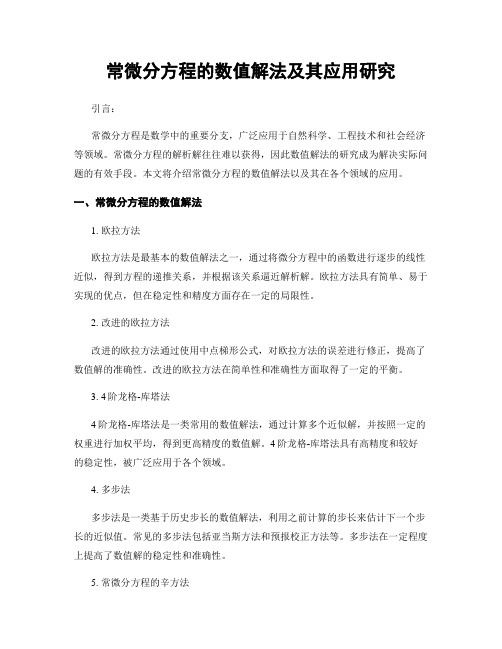
常微分方程的数值解法及其应用研究引言:常微分方程是数学中的重要分支,广泛应用于自然科学、工程技术和社会经济等领域。
常微分方程的解析解往往难以获得,因此数值解法的研究成为解决实际问题的有效手段。
本文将介绍常微分方程的数值解法以及其在各个领域的应用。
一、常微分方程的数值解法1. 欧拉方法欧拉方法是最基本的数值解法之一,通过将微分方程中的函数进行逐步的线性近似,得到方程的递推关系,并根据该关系逼近解析解。
欧拉方法具有简单、易于实现的优点,但在稳定性和精度方面存在一定的局限性。
2. 改进的欧拉方法改进的欧拉方法通过使用中点梯形公式,对欧拉方法的误差进行修正,提高了数值解的准确性。
改进的欧拉方法在简单性和准确性方面取得了一定的平衡。
3. 4阶龙格-库塔法4阶龙格-库塔法是一类常用的数值解法,通过计算多个近似解,并按照一定的权重进行加权平均,得到更高精度的数值解。
4阶龙格-库塔法具有高精度和较好的稳定性,被广泛应用于各个领域。
4. 多步法多步法是一类基于历史步长的数值解法,利用之前计算的步长来估计下一个步长的近似值。
常见的多步法包括亚当斯方法和预报校正方法等。
多步法在一定程度上提高了数值解的稳定性和准确性。
5. 常微分方程的辛方法辛方法是一类特殊的数值解法,能够保持微分方程的守恒性质。
辛方法在长时间积分和保持能量守恒方面具有优势,被广泛应用于天体力学和分子动力学等领域。
二、常微分方程数值解法的应用1. 物理科学中的应用常微分方程的数值解法在物理学中有广泛的应用,如天体力学中的行星轨道计算、量子力学中的薛定谔方程求解等。
数值解法处理了复杂的物理现象,为物理学研究提供了可行的途径。
2. 工程技术中的应用常微分方程的数值解法在工程技术中被广泛应用,如电路分析、结构力学、流体力学等。
通过数值解法,可以模拟和分析复杂的工程问题,提供设计和优化方案。
3. 经济学中的应用经济学中的许多问题可以转化为常微分方程的形式,如经济增长模型、市场供需关系等。
求常微分方程的数值解

求常微分方程的数值解一、背景介绍常微分方程(Ordinary Differential Equation,ODE)是描述自然界中变化的数学模型。
常微分方程的解析解往往难以求得,因此需要寻找数值解来近似地描述其行为。
求解常微分方程的数值方法主要有欧拉法、改进欧拉法、龙格-库塔法等。
二、数值方法1. 欧拉法欧拉法是最简单的求解常微分方程的数值方法之一。
它基于导数的定义,将微分方程转化为差分方程,通过迭代计算得到近似解。
欧拉法的公式如下:$$y_{n+1}=y_n+f(t_n,y_n)\Delta t$$其中,$y_n$表示第$n$个时间步长处的函数值,$f(t_n,y_n)$表示在$(t_n,y_n)$处的导数,$\Delta t$表示时间步长。
欧拉法具有易于实现和理解的优点,但精度较低。
2. 改进欧拉法(Heun方法)改进欧拉法又称Heun方法或两步龙格-库塔方法,是对欧拉法进行了精度上提升后得到的一种方法。
它利用两个斜率来近似函数值,并通过加权平均来计算下一个时间步长处的函数值。
改进欧拉法的公式如下:$$k_1=f(t_n,y_n)$$$$k_2=f(t_n+\Delta t,y_n+k_1\Delta t)$$$$y_{n+1}=y_n+\frac{1}{2}(k_1+k_2)\Delta t$$改进欧拉法比欧拉法精度更高,但计算量也更大。
3. 龙格-库塔法(RK4方法)龙格-库塔法是求解常微分方程中最常用的数值方法之一。
它通过计算多个斜率来近似函数值,并通过加权平均来计算下一个时间步长处的函数值。
RK4方法是龙格-库塔法中最常用的一种方法,其公式如下:$$k_1=f(t_n,y_n)$$$$k_2=f(t_n+\frac{\Delta t}{2},y_n+\frac{k_1\Delta t}{2})$$ $$k_3=f(t_n+\frac{\Delta t}{2},y_n+\frac{k_2\Delta t}{2})$$ $$k_4=f(t_n+\Delta t,y_n+k_3\Delta t)$$$$y_{n+1}=y_n+\frac{1}{6}(k_1+2k_2+2k_3+k_4)\Delta t$$三、数值求解步骤对于给定的常微分方程,可以通过以下步骤求解其数值解:1. 确定初值条件:确定$t=0$时刻的函数值$y(0)$。
常微分方程中的数值方法

常微分方程中的数值方法常微分方程是数学中的一个重要分支。
它主要研究的对象是随时间变化的函数。
在实际应用中,我们需要求解这些函数的解析解,但通常情况下,解析解并不容易得到,甚至是不可能得到。
因此,我们需要使用数值方法来求解这些函数的数值近似解。
在本文中,我们将介绍常微分方程中的数值方法。
一、欧拉法欧拉法是常微分方程数值解法中最基本的一种方法。
它是根据欧拉公式推导而来的。
具体地,我们可以将一阶常微分方程dy/dt=f(t,y)写成如下形式:y(t+h)=y(t)+hf(t,y(t))其中,h是步长,f(t,y)是t时刻y的导数。
欧拉法就是通过上面的公式进行逐步逼近,然后得到最终的数值解。
欧拉法的计算过程非常简单,但所得到的解可能会出现误差。
这是因为欧拉法忽略了f(t+h,y(t+h))和f(t,y(t))之间的变化。
因此,我们需要使用更为精确的数值方法来解决这个问题。
二、改进欧拉法为了解决欧拉法中的误差问题,我们可以使用改进欧拉法。
改进欧拉法又称作四阶龙格-库塔法。
它的基本思想是对欧拉法公式进行改进,以提高计算精度。
具体地,根据龙格-库塔公式,可将改进欧拉法表示为:y(t+h)=y(t)+1/6(k1+2k2+2k3+k4)其中,k1=h*f(t,y)k2=h*f(t+h/2,y+k1/2)k3=h*f(t+h/2,y+k2/2)k4=h*f(t+h,y+k3)改进欧拉法的计算过程比欧拉法要复杂些,但所得到的数值解比欧拉法更精确。
这种方法适用于一些特殊的问题,但在求解一些更为复杂的问题时,还需要使用其他的数值方法。
三、龙格-库塔法龙格-库塔法是求解常微分方程中数值解的常用方法之一。
它最常用的是四阶龙格-库塔法。
这种方法的基本思想是使用四个不同的斜率来计算数值解。
具体地,我们可以将四阶龙格-库塔法表示为:y(t+h)=y(t)+1/6(k1+2k2+2k3+k4)其中,k1=h*f(t,y)k2=h*f(t+h/2,y+k1/2)k3=h*f(t+h/2,y+k2/2)k4=h*f(t+h,y+k3)与改进欧拉法相比,龙格-库塔法的计算复杂度更高,但所得到的数值解更为精确。
常微分方程的数值解法
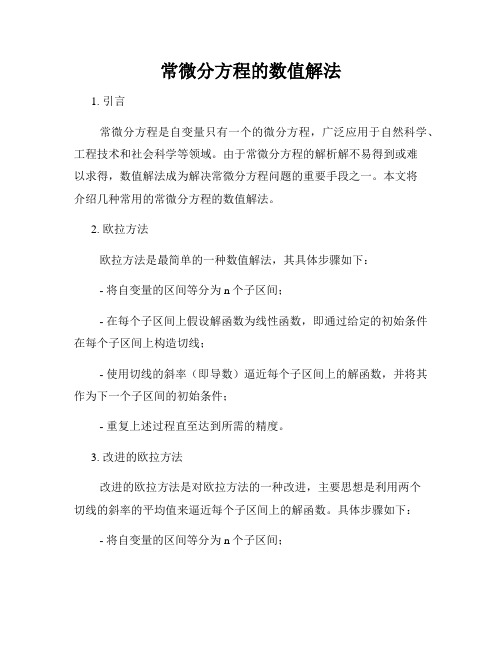
常微分方程的数值解法1. 引言常微分方程是自变量只有一个的微分方程,广泛应用于自然科学、工程技术和社会科学等领域。
由于常微分方程的解析解不易得到或难以求得,数值解法成为解决常微分方程问题的重要手段之一。
本文将介绍几种常用的常微分方程的数值解法。
2. 欧拉方法欧拉方法是最简单的一种数值解法,其具体步骤如下:- 将自变量的区间等分为n个子区间;- 在每个子区间上假设解函数为线性函数,即通过给定的初始条件在每个子区间上构造切线;- 使用切线的斜率(即导数)逼近每个子区间上的解函数,并将其作为下一个子区间的初始条件;- 重复上述过程直至达到所需的精度。
3. 改进的欧拉方法改进的欧拉方法是对欧拉方法的一种改进,主要思想是利用两个切线的斜率的平均值来逼近每个子区间上的解函数。
具体步骤如下: - 将自变量的区间等分为n个子区间;- 在每个子区间上构造两个切线,分别通过给定的初始条件和通过欧拉方法得到的下一个初始条件;- 取两个切线的斜率的平均值,将其作为该子区间上解函数的斜率,并计算下一个子区间的初始条件;- 重复上述过程直至达到所需的精度。
4. 二阶龙格-库塔方法二阶龙格-库塔方法是一种更为精确的数值解法,其基本思想是通过近似计算解函数在每个子区间上的平均斜率。
具体步骤如下: - 将自变量的区间等分为n个子区间;- 在每个子区间上计算解函数的斜率,并以该斜率的平均值近似表示该子区间上解函数的斜率;- 利用该斜率近似值计算下一个子区间的初始条件,并进一步逼近解函数;- 重复上述过程直至达到所需的精度。
5. 龙格-库塔法(四阶)龙格-库塔法是目前常用的数值解法之一,其精度较高。
四阶龙格-库塔法是其中较为常用的一种,其具体步骤如下:- 将自变量的区间等分为n个子区间;- 在每个子区间上进行多次迭代计算,得到该子区间上解函数的近似值;- 利用近似值计算每个子区间上的斜率,并以其加权平均值逼近解函数的斜率;- 计算下一个子区间的初始条件,并进一步逼近解函数;- 重复上述过程直至达到所需的精度。
常微分方程数值解法

第七章 常微分方程数值解法常微分方程中只有一些典型方程能求出初等解(用初等函数表示的解),大部分的方程是求不出初等解的。
另外,有些初值问题虽然有初等解,但由于形式太复杂不便于应用。
因此,有必要探讨常微分方程初值问题的数值解法。
本章主要介绍一阶常微分方程初值问题的欧拉法、龙格-库塔法、阿达姆斯方法,在此基础上推出一阶微分方程组与高阶方程初值问题的 数值解法;此外,还将简要介绍求解二阶常微分方程值问题的差分方法、试射法。
第一节 欧拉法求解常微分方程初值问题⎪⎩⎪⎨⎧==00)(),(y x y y x f dxdy(1)的数值解,就是寻求准确解)(x y 在一系列离散节点 <<<<<n x x x x 210 上的近似值 ,,,,,210n y y y y{}n y 称为问题的数值解,数值解所满足的离散方程统称为差分格式,1--=i i ix x h 称为步长,实用中常取定步长。
显然,只有当初值问题(1)的解存在且唯一时,使用数值解法才有意义,这一前提条件由下 面定理保证。
定理 设函数()y x f ,在区域+∞≤≤-∞≤≤y b x a D ,:上连续,且在区域D 内满足李普希兹(Lipschitz)条件,即存在正数L ,使得对于R 内任意两点()1,y x 与()2,y x ,恒有()()2121,,y y L y x f y x f -≤-则初值问题(1)的解()x y 存在并且唯一。
一、欧拉法(欧拉折线法)若将函数)xy 在点nx处的导数()n x y '用两点式代替, 即()hx y x y x y n n n )()(1-≈'+,再用n y 近似地代替()n x y ,则初值问题(1)变为⎩⎨⎧==++=+ ,2,1,0),()(001n x y y y x hf y y n n n n(2)(2)式就是著名的欧拉(Euler)公式。
以上方法称 为欧 拉法或欧拉折线法。
数值计算中的常微分方程数值模拟

数值计算中的常微分方程数值模拟在数值计算中,常微分方程(Ordinary Differential Equations,简称ODE)是一个重要的研究对象。
常微分方程的数值模拟是通过数值方法对其进行近似求解的过程,该过程对于模拟物理系统、生物学过程以及工程问题等具有重要意义。
本文将介绍常微分方程数值模拟的几种常用方法,并分析其特点与应用。
一、欧拉法(Euler's Method)欧拉法是最简单的常微分方程数值模拟方法之一,其基本思想是将连续的微分方程进行离散化,使用一阶差分近似代替微分。
具体步骤如下:1. 建立微分方程:设待求解的微分方程为dy/dx = f(x, y),其中f(x, y)为已知函数。
2. 初始化:选择初始条件y0 = y(x0),以及离散步长h。
3. 迭代求解:根据欧拉法的迭代公式yn+1 = yn + h * f(xn, yn)进行近似求解。
欧拉法的优点是简单易实现,但在处理复杂问题和大步长时存在精度较低的问题。
二、改进的欧拉法(Improved Euler's Method)为了提高欧拉法的精度,改进的欧拉法在迭代过程中使用两个不同的斜率近似值,从而对解进行更准确的预测并修正。
具体步骤如下:1. 建立微分方程:同欧拉法。
2. 初始化:同欧拉法。
3. 迭代求解:根据改进的欧拉法的迭代公式yn+1 = yn + h * (k1 +k2)/2进行近似求解,其中k1 = f(xn, yn),k2 = f(xn + h, yn + h * k1)。
改进的欧拉法在精度上优于欧拉法,但仍然不适用于高精度要求的问题。
三、龙格-库塔法(Runge-Kutta Methods)龙格-库塔法是一类常微分方程数值模拟方法,通过计算多个不同次数的斜率来逼近解。
其中,四阶龙格-库塔方法是最常用的一种方法。
具体步骤如下:1. 建立微分方程:同欧拉法。
2. 初始化:同欧拉法。
3. 迭代求解:根据四阶龙格-库塔方法的迭代公式yn+1 = yn + h * (k1 + 2k2 + 2k3 + k4)/6进行近似求解,其中k1 = f(xn, yn),k2 = f(xn + h/2, yn + h/2 * k1),k3 = f(xn + h/2, yn + h/2 * k2),k4 = f(xn + h, yn + h * k3)。
常微分方程数值解法
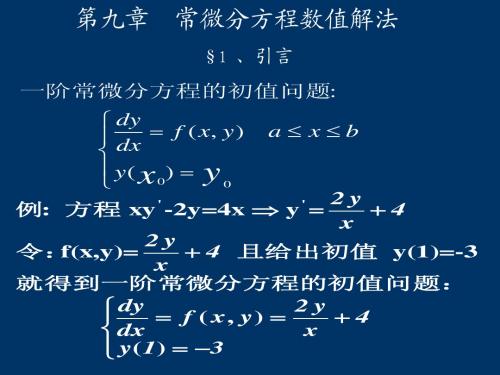
ρ ρ
n+1 n
≤1
三、梯形公式
由 分 径 y ( xn+1) = y ( xn) + 积 途 : xn+1
∫
f ( x, y)dt
(
积分 梯形 式 且令:yn+1 = y( xn+1), yn = y( xn) 用 公 , h 则 yn+1 = yn + ( f (xn , yn) + f (xn+1 , yn+1)) 得: 2
第九章 常微分方程数值解法
§1 、引言
一 常 分 程 初 问 : 阶 微 方 的 值 题 dy dx = f (x, y) y( x0) = y0
'
a ≤ x ≤b
2 y 例 : 方 程 xy -2 y = 4 x ⇒ y = + 4 x 2 y 令 :f ( x , y ) = + 4 且 给 出 初 值 y (1 )= -3 x 就 得 到 一 阶 常 微 分 方 程 的 初 值 问 题 : 2 y dy = f (x, y) = + 4 dx x y(1) = − 3
n n n n n 2 // n n+1
~
y
n+1
= yn + hf ( xn, yn ) = y(xn) + hf
n+1
~
y
n+1
( x , y( x ))
n n
则 T = y( x ) − = h y (ξ ) x y 2 ~
// n+1 n+1
2
n
< ξ < xn+1
令
常微分方程组数值解法

常微分方程组数值解法一、引言常微分方程组是数学中的一个重要分支,它在物理、工程、生物等领域都有广泛应用。
对于一些复杂的常微分方程组,往往难以通过解析方法求解,这时候数值解法就显得尤为重要。
本文将介绍常微分方程组数值解法的相关内容。
二、数值解法的基本思想1.欧拉法欧拉法是最基础的数值解法之一,它的思想是将时间连续化,将微分方程转化为差分方程。
对于一个一阶常微分方程y'=f(x,y),其欧拉公式为:y_{n+1}=y_n+hf(x_n,y_n)其中h为步长,x_n和y_n为第n个时间点上x和y的取值。
2.改进欧拉法改进欧拉法是对欧拉法的改良,其公式如下:y_{n+1}=y_n+\frac{h}{2}[f(x_n,y_n)+f(x_{n+1},y_n+hf(x_n,y_n))] 3.四阶龙格-库塔方法四阶龙格-库塔方法是目前最常用的数值解法之一。
其公式如下:k_1=f(x_n,y_n)k_2=f(x_n+\frac{h}{2},y_n+\frac{h}{2}k_1)k_3=f(x_n+\frac{h}{2},y_n+\frac{h}{2}k_2)k_4=f(x_n+h,y_n+hk_3)y_{n+1}=y_n+\frac{h}{6}(k_1+2k_2+2k_3+k_4)其中,k_i为中间变量。
三、常微分方程组的数值解法1.欧拉法对于一个二阶常微分方程组:\begin{cases} y'_1=f_1(x,y_1,y_2) \\ y'_2=f_2(x,y_1,y_2)\end{cases}其欧拉公式为:\begin{cases} y_{n+1,1}=y_{n,1}+hf_1(x_n,y_{n,1},y_{n,2}) \\y_{n+1,2}=y_{n,2}+hf_2(x_n,y_{n,1},y_{n,2}) \end{cases}其中,x_n和y_{n,i}(i=1, 2)为第n个时间点上x和y_i的取值。
常微分方程数值解法
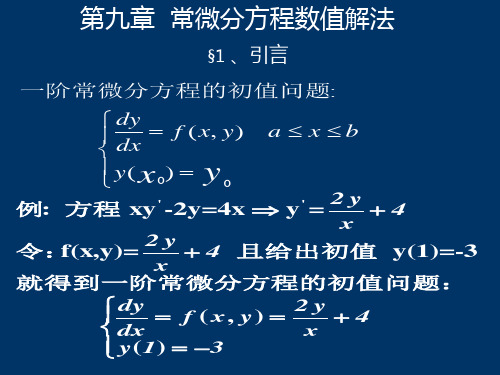
用分段的折线逼近函数,此为 “折线法”而非“切线法”, 除第一个点是曲线上的切线,
其它都不是。
2、Euler方法的误差估计
1)局部截断误差。 在一步中产生的误差而非累积误差:
~
T x y y
n1
n1
n1
其中
~
y
是当
y
n
y(
x
)
n
(精确解!)时
n1
由Euler法求出的值,即y 无误差! n
T x y h y 则
y
n1
~
2
n1
n1 2
//
x x
n
n1
令 M 2 max y// (x) , y(x) 充分光滑,则: a xb
T M h h n 1
2
O 2 22
3、 总体方法误差(1)
递推方法:从任意两相邻步的总体误差关系
第九章 常微分方程数值解法
§1 、引言
一阶常微分方程的初值问题:
dy
dx
f (x, y)
a xb
y
(
x
)
0
y 0
例: 方程 xy' -2y=4x y' = 2 y 4 x
令:f(x,y)= 2 y 4 且给出初值 y(1)=-3 x
就得到一阶常微分方程的初值问题:
n
n
n1
y y x y hf ( , ) n 0, 1, 2,
n1
n
n
n
Taylor展开法不仅可得到求数值解的公式,且容易估计
截断误差。
§2 尤拉(Eular)方法
常微分方程的数值解法

常微分方程的数值解法常微分方程是研究变量的变化率与其当前状态之间的关系的数学分支。
它在物理、工程、经济等领域有着广泛的应用。
解常微分方程的精确解往往十分困难甚至不可得,因此数值解法在实际问题中起到了重要的作用。
本文将介绍常见的常微分方程的数值解法,并比较其优缺点。
1. 欧拉方法欧拉方法是最简单的数值解法之一。
它基于近似替代的思想,将微分方程中的导数用差商近似表示。
具体步骤如下:(1)确定初始条件,即问题的初值。
(2)选择相应的步长h。
(3)根据微分方程的定义使用近似来计算下一个点的值。
欧拉方法的计算简单,但是由于误差累积,精度较低。
2. 改进欧拉方法为了提高欧拉方法的精度,改进欧拉方法应运而生。
改进欧拉方法通过使用两个点的斜率的平均值来计算下一个点的值。
具体步骤如下:(1)确定初始条件,即问题的初值。
(2)选择相应的步长h。
(3)根据微分方程的定义使用近似来计算下一个点的值。
改进欧拉方法相较于欧拉方法而言,精度更高。
3. 龙格-库塔法龙格-库塔法(Runge-Kutta)是常微分方程数值解法中最常用的方法之一。
它通过迭代逼近精确解,并在每一步中计算出多个斜率的加权平均值。
具体步骤如下:(1)确定初始条件,即问题的初值。
(2)选择相应的步长h。
(3)计算各阶导数的导数值。
(4)根据权重系数计算下一个点的值。
与欧拉方法和改进欧拉方法相比,龙格-库塔法的精度更高,但计算量也更大。
4. 亚当斯法亚当斯法(Adams)是一种多步法,它利用之前的解来近似下一个点的值。
具体步骤如下:(1)确定初始条件,即问题的初值。
(2)选择相应的步长h。
(3)通过隐式或显式的方式计算下一个点的值。
亚当斯法可以提高精度,并且比龙格-库塔法更加高效。
5. 多步法和多级法除了亚当斯法,还有其他的多步法和多级法可以用于解常微分方程。
多步法通过利用多个点的值来逼近解,从而提高精度。
而多级法则将步长进行分割,分别计算每个子问题的解,再进行组合得到整体解。
常微分方程的数值解法全文

第8章常微分方程的数值解法8.4单步法的收敛性与稳定性8.4.1相容性与收敛性上面所介绍的方法都是用离散化的方法,将微分方程初值问题化为差分方程初值问题求解的.这些转化是否合理?即当h →∞时,差分方程是否能无限逼近微分方程,差分方程的解n y 是否能无限逼近微分方程初值问题的准确解()n y x ,这就是相容性与收敛性问题.用单步法(8.3.14)求解初值问题(8.1.1),即用差分方程初值问题100(,,)()n n n n y y h x y h y x y ϕ+=+⎧⎨=⎩(8.4.1)的解作为问题(8.1.1)的近似解,如果近似是合理的,则应有()()(,(),)0 (0)y x h y x x y x h h hϕ+--→→(8.4.2)其中()y x 为问题(8.1.1)的精确解.因为0()()lim ()(,)h y x h y x y x f x y h→+-'==故由(8.4.2)得lim (,,)(,)h x y h f x y ϕ→=如果增量函数(,(),)x y x h ϕ关于h 连续,则有(,,0)(,)x y f x y ϕ=(8.4.3)定义8.3如果单步法的增量函数(,,)x y h ϕ满足条件(8.4.3),则称单步法(8.3.14)与初值问题(8.1.1)相容.通常称(8.4.3)为单步法的相容条件.满足相容条件(8.4.3)是可以用单步法求解初值问题(8.1.1)的必要条件.容易验证欧拉法和改进欧拉法均满足相容性条件.一般地,如果单步法有p 阶精度(1p ≥),则其局部截断误差为[]1()()(,(),)()p y x h y x h x y x h O h ϕ++-+=上式两端同除以h ,得()()(,,)()p y x h y x x y h O h hϕ+--=令0h →,如果(,(),)x y x h ϕ连续,则有()(,,0)0y x x y ϕ'-=所以1p ≥的单步法均与问题(8.1.1)相容.由此即得各阶龙格-库塔法与初值问题(8.1.1)相容.定义8.4一种数值方法称为是收敛的,如果对于任意初值0y 及任意固定的(,]x a b ∈,都有lim () ()n h y y x x a nh →==+其中()y x 为初值问题(8.1.1)的精确解.如果我们取消局部化假定,使用某单步法公式,从0x 出发,一步一步地推算到1n x +处的近似值1n y +.若不计各步的舍入误差,而每一步都有局部截断误差,这些局部截断误差的积累就是整体截断误差.定义8.5称111()n n n e y x y +++=-为某数值方法的整体截断误差.其中()y x 为初值问题(8.1.1)的精确解,1n y +为不计舍入误差时用某数值方法从0x 开始,逐步得到的在1n x +处的近似值(不考虑舍入误差的情况下,局部截断误差的积累).定理8.1设单步法(8.3.14)具有p 阶精度,其增量函数(,,)x y h ϕ关于y 满足利普希茨条件,问题(8.1.1)的初值是精确的,即00()y x y =,则单步法的整体截断误差为111()()p n n n e y x y O h +++=-=证明由已知,(,,)x y h ϕ关于y 满足利普希茨条件,故存在0L >,使得对任意的12,y y 及[,]x a b ∈,00h h <≤,都有1212(,,)(,,)x y h x y h L y y ϕϕ-≤-记1()(,(),)n n n n y y x h x y x h ϕ+=+,因为单步法具有p 阶精度,故存在0M >,使得1111()p n n n R y x y Mh ++++=-≤从而有111111111()()()(,(),)(,,)()(,(),)(,,)n n n n n n n p n n n n n n p n n n n n n e y x y y x y y y Mh y x h x y x h y h x y h Mh y x y h x y x h x y h ϕϕϕϕ+++++++++=-≤-+-≤++--≤+-+-1(1)p nMh hL e +≤++反复递推得11111101110(1)(1)1(1)(1)(1)(1)1(1)p p n n n p n n p n e Mh hL Mh hL e hL hL Mh hL e hL Mh hL e hL+++-+++++⎡⎤≤++++⎣⎦⎡⎤≤+++++++⎣⎦+-≤++因为00()y x y =,即00e =,又(1)n h b a +≤-,于是ln(1)1()(1)(1)b a b a hL n L b a h h hL hL e e --++-+≤+=≤所以()11()p L b a p n M e h e O h L -+⎡⎤≤-=⎣⎦推论设单步法具有p (1p ≥)阶精度,增量函数(,,)x y h ϕ在区域G :, , 0a x b y h h ≤≤-∞<<+∞≤≤上连续,且关于y 满足利普希茨条件,则单步法是收敛的.当(,)f x y 在区域:,D a x b y ≤≤-∞<<+∞上连续,且关于y 满足利普希茨条件时,改进欧拉法,各阶龙格-库塔法的增量函数(,,)x y h ϕ在区域G 上连续,且关于y 满足利普希茨条件,因而它们都是收敛的.关于单步法收敛的一般结果是:定理8.2设增量函数(,,)x y h ϕ在区域G 上连续,且关于y 满足利普希茨条件,则单步法收敛的充分必要条件是相容性条件(8.4.3).8.4.2稳定性稳定性与收敛性是两个不同的概念,收敛性是在假定每一步计算都准确的前提下,讨论当步长0h →时,方法的整体截断误差是否趋于零的问题.而稳定性则是讨论舍入误差的积累能否对计算结果有严重影响的问题.定义8.6若一种数值方法在节点值n y 上有一个大小为δ的扰动,于以后各节点()m y m n >上产生的偏差均不超过δ,则称该方法是稳定的.我们以欧拉法为例进行讨论.假设由于舍入误差,实际得到的不是n y 而是n n n y y δ=+,其中n δ是误差.由此再计算一步,得到1(,)n n n n y y hf x y +=+把它与不考虑舍入误差的欧拉公式相减,并记111n n n y y δ+++=-,就有[]1(,)(,)1(,)n n n n n n y n nh f x y f x y hf x δδηδ+⎡⎤=+-=+⎣⎦其中y f f y∂=∂.如果满足条件1(,)1y n hf x η+≤,(8.4.4)则从n y 到1n y +的计算,误差是不增的,可以认为计算是稳定的.如果条件(8.4.4)不满足,则每步误差将增大.当0y f >时,显然条件(8.4.4)不可能满足,我们认为问题本身具有先天的不稳定性.当0y f <时,为了满足稳定性要求(8.4.4),有时h 要很小.一般的,稳定性与方法有关,也与步长h 的大小有关,当然也与方程中的(,)f x y 有关.为简单起见,通常只考虑数值方法用于求解模型方程的稳定性,模型方程为y y λ'=(8.4.5)其中λ为复数.一般的方程可以通过局部线性化转化为模型方程,例如在(,)x y 的邻域(,)(,)(,)()(,)()x y y f x y f x y f x y x x f x y y y '==+-+-+略去高阶项,再作变量替换就得到u u λ'=的形式.对于模型方程(8.4.5),若Re 0λ>,类似以上分析,可以认为方程是不稳定的.所以我们只考虑Re 0λ<的情形,这时不同的数值方法可能是数值稳定的或者是数值不稳定的.当一个单步法用于试验方程y y λ'=,从n y 计算一步得到1()n n y E h y λ+=(8.4.6)其中()E h λ依赖于所选的方法.因为通过点(,)n n x y 试验方程的解曲线(它满足,()n n y y y x y λ'==)为[]exp ()n n y y x x λ=-,而一个p 阶单步法的局部截断误差在()n n y x y =时有1111()()p n n n T y x y O h ++++=-=,所以有1exp()()()p n n y h E h y O h λλ+-=(8.4.7)这样可以看出()E h λ是h e λ的一个近似值.由(8.4.6)可以看到,若n y 计算中有误差ε,则计算1n y +时将产生误差()E h λε,所以有下面定义.定义8.7如果(8.4.6)式中,()1E h λ<,则称单步法(8.3.14)是绝对稳定的.在复平面上复变量h λ满足()1E h λ<的区域,称为方法(8.3.14)的绝对稳定区域,它与实轴的交称为绝对稳定区间.在上述定义中,规定严格不等式成立,是为了和线性多步法的绝对稳定性定义一致.事实上,()1E h λ=时也可以认为误差不增长.(1)欧拉法的稳定性欧拉法用于模型方程(8.4.5),得1(1)n n y h y λ+=+,所以有()1E h h λλ=+.所以绝对稳定条件是11h λ+<,它的绝对稳定区域是h λ复平面上以(1,0)-为中心的单位圆,见图8.3.而λ为实数时,绝对稳定区间是(2,0)-.Im()h λRe()h λ2-1-O 图8.3欧拉法的绝对稳定区域(2)梯形公式的稳定性对模型方程,梯形公式的具体表达式为11()2n n n n h y y y y λλ++=++,即11212n nh y y h λλ++=-,所以梯形公式的绝对稳定区域为12112h h λλ+<-.化简得Re()0h λ<,因此梯形公式的绝对稳定区域为h λ平面的左半平面,见图8.4.特别地,当λ为负实数时,对任意的0h >,梯形公式都是稳定的.Im()h λRe()h λO 图8.4梯形公式的绝对稳定区域(3)龙格-库塔法的稳定性与前面的讨论相仿,将龙格-库塔法用于模型方程(8.4.5),可得二、三、四阶龙格-库塔法的绝对稳定区域分别为211()12h h λλ++<23111()()126h h h λλλ+++<2341111()()()12624h h h h λλλλ++++<当λ为实数时,二、三、四阶显式龙格-库塔法的绝对稳定区域分别为20h λ-<<、2.510h λ-<<、 2.780h λ-<<.例8.5设有初值问题21010101(0)0xy y x x y ⎧'=-≤≤⎪+⎨⎪=⎩用四阶经典龙格-库塔公式求解时,从绝对稳定性考虑,对步长h 有何限制?解对于所给的微分方程有2100,(010)1f x x y xλ∂==-<≤≤∂+在区间[0,10]上,有201010max ||max51t x x λ<<==+由于四阶经典龙格-库塔公式的绝对稳定区间为 2.7850h λ-<<,则步长h 应满足00.557h <<.。
数值方法常微分方程

数值方法常微分方程数值方法是一种近似求解常微分方程(ODEs)的方法,它是通过将连续问题离散化为离散问题来实现的。
常微分方程是数学中常见的用于描述动态系统的工具,它描述了未知函数与其导数之间的关系。
求解常微分方程对于预测系统的行为和发展非常重要。
在许多现实问题中,解析求解常微分方程是非常困难甚至不可能的。
而数值方法则提供了一种近似求解常微分方程的有效和可行的途径。
数值方法基于将微分方程中的函数在离散的点上进行近似,通过计算函数的离散解来预测函数在给定时间和空间范围内的行为。
常用的数值方法包括欧拉方法、隐式欧拉方法、梯形规则、龙格-库塔方法(RK4)、多步法等。
在数值方法中,最简单的方法是欧拉方法(Euler method)。
该方法将微分方程中的导数用差分代替,通过迭代逼近函数的解。
该方法的基本思想是通过将微分方程近似为差分方程,在离散的时间点上计算函数的值。
欧拉方法的计算公式是:y[i+1]=y[i]+h*f(t[i],y[i])其中,y[i]是在时间点t[i]处的函数的近似值,h是时间步长,f(t[i],y[i])是在时间t[i]和函数y[i]处的导数值。
尽管欧拉方法是最简单的数值方法之一,但它有一些局限性。
首先,它对步长的选择非常敏感,步长选择过大或过小都可能导致数值解的不稳定性。
其次,欧拉方法的精度较低,由于使用了一阶近似,所以在一些情况下可能会产生较大的误差。
因此,为了提高数值解的精度和稳定性,我们需要使用更高阶的数值方法。
龙格-库塔方法(RK方法)是一种常用的、高阶的数值方法。
它是一系列积分方法的集合,其中RK4是最常用的方法之一、RK4可以通过使用连续的斜率来计算函数值的改变量,在四个时间点上进行计算。
该方法的计算公式为:k1=h*f(t[i],y[i])k2=h*f(t[i]+h/2,y[i]+k1/2)k3=h*f(t[i]+h/2,y[i]+k2/2)k4=h*f(t[i]+h,y[i]+k3)y[i+1]=y[i]+1/6*(k1+2*k2+2*k3+k4)与欧拉方法相比,RK4方法具有更高的精度。
数值解常微分方程的方法和技巧

数值解常微分方程的方法和技巧在科学和工程领域,我们经常遇到一些复杂的常微分方程(Ordinary Differential Equations, ODEs),这些方程往往很难用解析方法得到精确解。
而数值解常微分方程的方法和技巧提供了一种有效的途径来近似求解这些方程。
本文将介绍一些常用的数值解ODEs的方法和技巧。
一、欧拉方法(Euler Method)欧拉方法是最简单的数值解ODEs的方法,它利用初始条件和微分方程的导数来计算下一个点的近似值。
具体来说,假设我们要求解的ODE为dy/dx = f(x, y),其中f(x, y)是已知函数,初始条件为x0 = x(0),y0 = y(0)。
欧拉方法的迭代公式为:y[i+1] = y[i] + h * f(x[i], y[i])其中,h是步长,x[i]表示第i个点的x坐标,y[i]表示对应的y坐标。
二、龙格-库塔方法(Runge-Kutta Method)龙格-库塔方法是一族常用的数值解ODEs方法,其基本思想是通过计算不同阶数的导数来提高求解的精度。
最常用的龙格-库塔方法是四阶龙格-库塔方法,也称为RK4方法。
它的迭代公式如下:k1 = h * f(x[i], y[i])k2 = h * f(x[i] + h/2, y[i] + k1/2)k3 = h * f(x[i] + h/2, y[i] + k2/2)k4 = h * f(x[i] + h, y[i] + k3)y[i+1] = y[i] + 1/6 * (k1 + 2*k2 + 2*k3 + k4)其中,k1、k2、k3、k4是中间变量,h是步长。
三、改进的欧拉方法(Improved Euler Method)改进的欧拉方法是对欧拉方法的改进,它通过使用导数的平均值来提高求解的精度。
其迭代公式为:k1 = h * f(x[i], y[i])k2 = h * f(x[i] + h, y[i] + k1)y[i+1] = y[i] + 1/2 * (k1 + k2)其中,k1、k2是中间变量,h是步长。
常微分方程数值解法
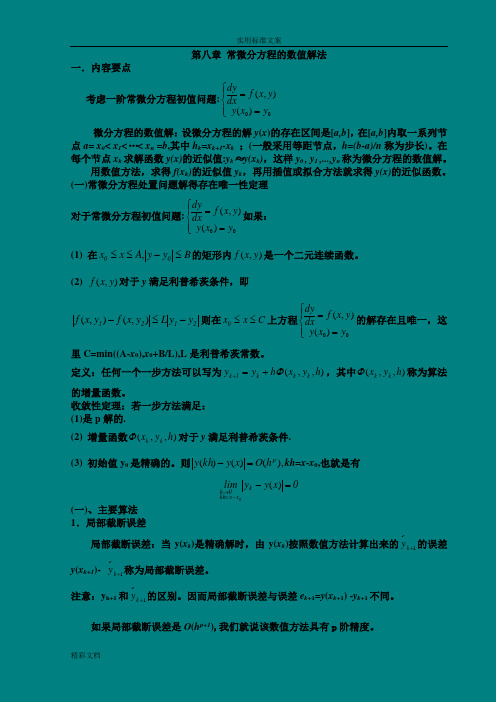
第八章 常微分方程的数值解法一.内容要点考虑一阶常微分方程初值问题:⎪⎩⎪⎨⎧==00)(),(y x y y x f dx dy微分方程的数值解:设微分方程的解y (x )的存在区间是[a,b ],在[a,b ]内取一系列节点a= x 0< x 1<…< x n =b ,其中h k =x k+1-x k ;(一般采用等距节点,h=(b-a)/n 称为步长)。
在每个节点x k 求解函数y(x)的近似值:y k ≈y(x k ),这样y 0 , y 1 ,...,y n 称为微分方程的数值解。
用数值方法,求得f(x k )的近似值y k ,再用插值或拟合方法就求得y(x)的近似函数。
(一)常微分方程处置问题解得存在唯一性定理对于常微分方程初值问题:⎪⎩⎪⎨⎧==00)(),(y x y y x f dx dy如果:(1) 在B y y A x x 00≤-≤≤,的矩形内),(y x f 是一个二元连续函数。
(2) ),(y x f 对于y 满足利普希茨条件,即2121y y L y x f y x f -≤-),(),(则在C x x 0≤≤上方程⎪⎩⎪⎨⎧==00)(),(y x y y x f dxdy的解存在且唯一,这里C=min((A-x 0),x 0+B/L),L 是利普希茨常数。
定义:任何一个一步方法可以写为),,(h y x h y y k k k 1k Φ+=+,其中),,(h y x k k Φ称为算法的增量函数。
收敛性定理:若一步方法满足: (1)是p 解的.(2) 增量函数),,(h y x k k Φ对于y 满足利普希茨条件.(3) 初始值y 0是精确的。
则),()()(p h O x y kh y =-kh =x -x 0,也就是有0x y y lim k x x kh 0h 0=--=→)((一)、主要算法 1.局部截断误差局部截断误差:当y(x k )是精确解时,由y(x k )按照数值方法计算出来的1~+k y 的误差y (x k+1)- 1~+k y 称为局部截断误差。
第六章常微分方程的数值解法

第六章常微分方程的数值解法第六章常微分方程的数值解法在自然科学研究和工程技术领域中,常常会遇到常微分方程的求解问题。
传统的数学分析方法仅能给出一些简单的、常系数的、经典的线性方程的解析表达式,不能处理复杂的、变系数的、非线性方程,对于这些方面的问题,只能求诸于近似解法和数值解法。
而且在许多实际问题中,确确实实并不总是需要精确的解析解,往往只需获得近似的解或者解在若干个点上的数值即可。
在高等数学课程中介绍过的级数解法和逐步逼近法,能够给出解的近似表达式,这一类方法称为近似解法。
还有一类方法是通过计算机来求解微分方程的数值解,给出解在一些离散点上的近似值,这一类方法称作为数值方法。
本章主要介绍常微分方程初值问题的数值解法,包括Euler 方法、Runge-Kutta 方法、线性多步法以及微分方程组与高阶微分方程的数值解法。
同时,对于求解常微分方程的边值问题中比较常用的打靶法与有限差分法作了一个简单的介绍。
§1 基本概念1.1 常微分方程初值问题的一般提法常微分方程初值问题的一般提法是求解满足如下条件的函数,,b x a x y ≤≤)(=<<=α)(),(a y bx a y x f dxdy, (1.1) 其中),(y x f 是已知函数,α是给定的数值。
通常假定上面所给出的函数),(y x f 在给定的区域},),{(+∞<≤≤=yb x a y x D 上面满足如下条件:(1) 函数),(y x f 在区域D 上面连续;(2) 函数),(y x f 在区域D 上关于变量y 满足Lipschitz(李普希茨)条件:212121,),(),(y y b x a y y L y x f y x f ?≤≤?≤?,, (1.2)其中常数L 称为Lipschitz(李普希茨)常数。
由常微分方程的基本理论可以知道,假如(1.1)中的),(y x f 满足上面两个条件,则常微分方程初值问题(1.1)对于任意给定的初始值α都存在着唯一的解,,b x a x y ≤≤)(并且该唯一解在区间[a,b]上是连续可微的。
常微分方程数值解法

常微分方程数值解法常微分方程是研究函数的导数与自变量之间的关系的数学分支,广泛应用于物理、工程、生物等领域的建模与分析。
在实际问题中,我们常常遇到无法通过解析方法求得精确解的常微分方程,因此需要利用数值解法进行求解。
本文将介绍几种常用的常微分方程数值解法。
一、欧拉方法(Euler's Method)欧拉方法是最基本的数值解法之一。
它的思想是将微分方程转化为差分方程,通过逐步逼近解的方式求得数值解。
具体步骤如下:1. 将微分方程转化为差分方程:根据微分方程的定义,可以得到差分方程形式。
2. 选择步长:将自变量范围进行离散化,确定步长h。
3. 迭代计算:根据差分方程递推公式,利用前一步的数值解计算后一步的数值解。
二、改进的欧拉方法(Improved Euler's Method)改进的欧拉方法通过使用欧拉方法中的斜率来进行更准确的数值计算。
具体步骤如下:1. 计算欧拉方法的斜率:根据当前节点的数值解计算斜率。
2. 根据斜率计算改进的数值解:将得到的斜率代入欧拉方法的递推公式中,计算改进的数值解。
三、龙格-库塔方法(Runge-Kutta Method)龙格-库塔方法是一类常微分方程数值解法,其中最著名的是四阶龙格-库塔方法。
它通过计算各阶导数的加权平均值来逼近解,在精度和稳定性方面相对较高。
具体步骤如下:1. 计算每一步的斜率:根据当前节点的数值解计算每一步的斜率。
2. 计算权重:根据斜率计算各个权重。
3. 计算下一步的数值解:根据计算得到的权重,将其代入龙格-库塔方法的递推公式中,计算下一步的数值解。
四、多步法(多步差分法)多步法是需要利用多个前面节点的数值解来计算当前节点的数值解的数值方法。
常见的多步法有Adams-Bashforth法和Adams-Moulton法。
具体步骤如下:1. 选择初始值:根据差分方程的初始条件,确定初始值。
2. 迭代计算:根据递推公式,利用前面节点的数值解计算当前节点的数值解。
常微分方程初值问题的数值解法

常微分方程初值问题的数值解法在实际应用中,对于某些微分方程,我们并不能直接给出其解析解,需要通过数值方法来求得其近似解,以便更好地理解和掌握现象的本质。
常微分方程初值问题(IVP)即为一种最常见的微分方程求解问题,其求解方法有多种,本文将对常微分方程初值问题的数值解法进行较为详细的介绍。
一、欧拉法欧拉法是最基本的一种数值解法,它采用泰勒级数展开并截断低阶项,从而获得一个差分方程近似求解。
具体来讲,设 t 为独立变量,y(t) 为函数 y 关于 t 的函数,方程为:$$y'(t) = f(t, y(t)), \qquad y(t_0) = y_0$$其中 f(t,y(t)) 为已知的函数,y(t_0) 为已知的初值。
将函数 y(t) 进行泰勒级数展开:$$y(t+h) = y(t) + hf(t, y(t)) + O(h^2)$$其中 h 表示步长,O(h^2) 表示其他高阶项。
为了使误差较小,一般取步长 h 尽可能小,于是我们可以用欧拉公式表示数值解:$$y_{n+1} = y_n + hf(t_n, y_n), \qquad y_0 = y(t_0)$$欧拉法的优点是容易理解和实现,但是由于截取低阶项且使用的单步法,所以误差较大,精度较低,在具体应用时需要慎重考虑。
二、龙格-库塔法龙格-库塔法(Runge-Kutta method)是一种多步法,比欧拉法更加精确。
龙格-库塔法的主要思想是使用不同的插值多项式来计算近似解,并且将时间步长分解,每次计算需要多次求解。
以下简要介绍二阶和四阶龙格-库塔法。
二阶龙格-库塔法将时间步长 h 分解成两步 h/2,得到近似解表达式:$$\begin{aligned} k_1 &= hf(t_n, y_n)\\ k_2 &= hf(t_n+h/2,y_n+k_1/2)\\ y_{n+1} &= y_n+k_2+O(h^3)\\ \end{aligned}$$四阶龙格-库塔法四阶龙格-库塔法是龙格-库塔法中应用最为广泛的一种方法,其需要计算的中间值较多,但是具有更高的精度。
- 1、下载文档前请自行甄别文档内容的完整性,平台不提供额外的编辑、内容补充、找答案等附加服务。
- 2、"仅部分预览"的文档,不可在线预览部分如存在完整性等问题,可反馈申请退款(可完整预览的文档不适用该条件!)。
- 3、如文档侵犯您的权益,请联系客服反馈,我们会尽快为您处理(人工客服工作时间:9:00-18:30)。
常微分方程数值方法1、欧拉方法:1,,1,0),,(1-=+=+n k y t hf y y k k k k .function E=euler(f,a,b,ya,n)% Input - f is the function entered as a string 'f'% - a and b are the left and right end points% - ya is the initial condition y(a)% - n is the number of steps% Output - E=[T' Y'] where T is the vector of abscissas and% Y is the vector of ordinatesh=(b-a)/n;T=zeros(1,n+1);Y=zeros(1,n+1);T=a:h:b;Y(1)=ya;for j=1:nY(j+1)=Y(j)+h*feval(f,T(j),Y(j));endE=[T' Y'];【例】 用欧拉方法求解区间]3,0[内的初值问题:1)0(,2'=-=y yt y 。
f=inline('(t-y)/2','t','y');a=0;b=3;ya=1;n=12;%n=3,6,12,24,48,96...E=euler(f,a,b,ya,n),plot(E(:,1),E(:,2),'r*'),hold on符号解:y=dsolve('Dy=(t-y)/2','y(0)=1')h=(3-0)/12;t=0:h:3;y=eval(y);[t' y']用图比较数值解:(f 为ode 函数文件)ode45('f',[0,3],1)2、休恩(Huen)方法(即改进Euler 方法):1,,1,0)],,(,(),([211-=+++=++n k y t hf y t f y t f hy y k k k k k k k kfunction H=heun(f,a,b,ya,n)% Input - f is the function entered as a string 'f'% - a and b are the left and right end points% - ya is the initial condition y(a)% - n is the number of steps% Output - H=[T' Y'] where T is the vector of abscissas and% Y is the vector of ordinatesh=(b-a)/n;T=zeros(1,n+1);Y=zeros(1,n+1);T=a:h:b;Y(1)=ya;for j=1:nk1=feval(f,T(j),Y(j));k2=feval(f,T(j+1),Y(j)+h*k1);Y(j+1)=Y(j)+(h/2)*(k1+k2);endH=[T' Y'];【例】 用休恩方法求解区间]3,0[内的初值问题:1)0(,2'=-=y yt y 。
f=inline('(t-y)/2','t','y');a=0;b=3;ya=1;n=12;H=heun(f,a,b,ya,n),plot(H(:,1),H(:,2),'r*'),hold on用图比较数值解:(f 为ode 函数文件)ode45('f',[0,3],1)3、四阶龙格-库塔方法:)22(643211k k k k hy y k k ++++=+function R=rk4(f,a,b,ya,n)% Input - f is the function entered as a string 'f'% - a and b are the left and right end points% - ya is the initial condition y(a)% - n is the number of steps% Output - R=[T' Y'] where T is the vector of abscissas and% Y is the vector of ordinatesh=(b-a)/n;T=zeros(1,n+1);Y=zeros(1,n+1);T=a:h:b;Y(1)=ya;for j=1:nk1=h*feval(f,T(j),Y(j));k2=h*feval(f,T(j)+h/2,Y(j)+k1/2);k3=h*feval(f,T(j)+h/2,Y(j)+k2/2);k4=h*feval(f,T(j)+h,Y(j)+k3);Y(j+1)=Y(j)+(k1+2*k2+2*k3+k4)/6;endR=[T' Y'];【例】 用4阶龙格-库塔方法求解区间]3,0[内的初值问题:1)0(,2'=-=y yt y 。
f=inline('(t-y)/2','t','y');a=0;b=3;ya=1;n=3;R=rk4(f,a,b,ya,n)plot(R(:,1),R(:,2),'r*'),hold on用图比较数值解:(f 为ode 函数文件)ode45('f',[0,3],1)4、阿当姆斯-巴什弗斯-摩尔顿方法:(预测-校正公式)⎪⎪⎩⎪⎪⎨⎧++-+=+-+-+=+--+---)),(9195(24)5559379(241121123p x f f f f h y y ff f f h y p k k k k k k k k k k kfunction A=adams(f,T,Y)% Input - f is the function entered as a string 'f'% - T is the vector of abscissas% - Y is the vector of ordinates% Remark:The first four coordinates of T and% Y must have starting values obtained with RK4% Output - A=[T' Y'] where T is the vector of abscissas and% Y is the vector of ordinatesn=length(T);if n<5,break,end;F=zeros(1,4);F=feval(f,T(1:4),Y(1:4));h=T(2)-T(1);for k=4:n-1% Predictorp=Y(k)+(h/24)*(F*[-9 37 -59 55]');T(k+1)=T(1)+h*k;F=[F(2) F(3) F(4) feval(f,T(k+1),p)];% CorrectorY(k+1)=Y(k)+(h/24)*(F*[1 -5 19 9]');F(4)=feval(f,T(k+1),Y(k+1));endA=[T' Y'];【例】 求解区间]3,0[内的初值问题:1)0(,2'=-=y y t y 。
f=inline('(t-y)/2','t','y'); T=zeros(1,25);Y=zeros(1,25);T=0:1/8:3; Y(1:4)=[1 0.94323919 0.89749071 0.86208736];A=adams(f,T,Y)5、米尔尼-辛普生(Milne-simpson )方法:预测:)22(341231k k k k k f f f h y p +-+=---+ 修正:292811k k k k p y p m -+=++,),(111+++=k k k m t f f 校正:)4(31111+--++++=k k k k k f f f h y y function M=milne(f,T,Y)% Input - f is the function entered as a string 'f'% - T is the vector of abscissas% - Y is the vector of ordinates% Remark:The first four coordinates of T and% Y must have starting values obtained with RK4% Output - M=[T' Y'] where T is the vector of abscissas and% Y is the vector of ordinatesn=length(T);if n<5,break,end;F=zeros(1,4);F=feval(f,T(1:4),Y(1:4));h=T(2)-T(1);pold=0;yold=0;for k=4:n-1% Predictorpnew=Y(k-3)+(4*h/3)*(F(2:4)*[2 -1 2]');% Modifierpmod=pnew+28*(yold-pold)/29;T(k+1)=T(1)+h*k;F=[F(2) F(3) F(4) feval(f,T(k+1),pmod)];% CorrectorY(k+1)=Y(k-1)+(h/3)*(F(2:4)*[1 4 1]');pold=pnew;yold=Y(k+1);F(4)=feval(f,T(k+1),Y(k+1));endM=[T' Y'];【例】 求解区间]3,0[内的初值问题:1)0(,2'=-=y y t y 。
f=inline('(t-y)/2','t','y'); T=zeros(1,25);Y=zeros(1,25);T=0:1/8:3; Y(1:4)=[1 0.94323919 0.89749071 0.86208736];M=milne(f,T,Y)6、哈明(Hamming)方法:预测:)22(341231k k k k k f f f h y p +-+=---+ 校正:)),(2(83)9(8111121++--+++-++-=k k k k k k k p t f f f h y y y function H=hamming(f,T,Y)% Input - f is the function entered as a string 'f'% - T is the vector of abscissas% - Y is the vector of ordinates% Remark:The first four coordinates of T and% Y must have starting values obtained with RK4% Output - H=[T' Y'] where T is the vector of abscissas and% Y is the vector of ordinatesn=length(T);if n<5,break,end;F=zeros(1,4);F=feval(f,T(1:4),Y(1:4));h=T(2)-T(1);pold=0;cold=0;for k=4:n-1% Predictorpnew=Y(k-3)+(4*h/3)*(F(2:4)*[2 -1 2]');% Modifierpmod=pnew+112*(cold-pold)/121;T(k+1)=T(1)+h*k;F=[F(2) F(3) F(4) feval(f,T(k+1),pmod)];% Correctorcnew=(9*Y(k)-Y(k-2)+3*h*(F(2:4)*[-1 2 1]'))/8;Y(k+1)=Y(k-1)+(h/3)*(F(2:4)*[1 4 1]');pold=pnew;cold=cnew;F(4)=feval(f,T(k+1),Y(k+1));endH=[T' Y'];【例】 求解区间]3,0[内的初值问题:1)0(,2'=-=y y t y 。
